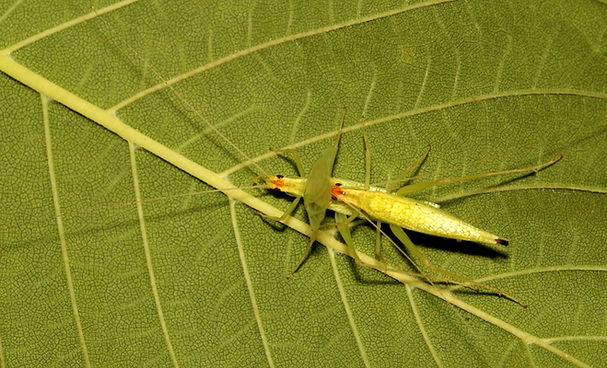Narrow-winged Tree Cricket

Narrow-winged Tree Cricket (Oecanthus niveus)
Occurrence
Very common
Habitat
Shrubs, smaller trees, occasionally found in meadow plants with broad leaves.
Range
All counties in our region
Physical description
Like many tree crickets, this species is light green and blends well with the leaves from which it sings. A closer look will reveal a small, reddish-orange patch on the top of its head. The color is not as extensive as the dramatic red of the Broad-winged Tree Cricket but is redder than the orange-ish patch on the Snowy-Tree Cricket’s head.

Song
These songs are not chirps. Each one is about 2-4 seconds in length, and there is a noticeable pause between each song. The overall song-pause-song-pause pattern is very rhythmic, repetitious and predictable. The pitch may be similar to that of the Snowy Tree Cricket with whom they often share the same habitat. If you listen for the longer songs and the pause between them, the distinction will become obvious. The two species' songs are compared on the Tree Cricket Introduction page.
Narrow-winged Tree Crickets typically sing at night but will begin singing before sunset later in the season.
The track below includes two different Narrow-winged Tree Crickets. The first one is at a slightly warmer temperature. In both cases, the rhythm is fairly consistent and each individual song is longer than the Snowy Tree Cricket and shorter and more rhythmically consistent than the Davis's.

General description and context
These crickets are likely to be above your head in a tree or tall shrub. I often find them in trees with broad leaves such as maples or swamp white oak, in vines such as poison ivy on tree trunks, and in larger shrubs. The males often sing from a notch in a leaf or from where two leaves meet or overlap.


They appear noticeably narrower than Snowy Tree Crickets because of their narrow wings. However, those wings do not look particularly narrow when singing – only when folded across their bodies. Females appear even narrower than males.

Narrow-winged Tree Cricket female

Mating pair. Female is climbing onto the male and is on top.
Similar species
Snowy Tree Crickets share similar habitats but have wider wings and a much shorter chirp-chirp-chirp song. Two-spotted Tree Crickets have intermittent songs, but the songs are usually longer, the pauses often a little shorter, and there is no regular song-pause phrase pattern as there is with the Narrow-winged.
The bigger challenge is differentiating between the Narrow-winged and the Davis’s Tree Cricket. Although the Davis’s are often higher in the trees, they also can be found in younger, smaller trees and ornamental trees with the Narrow-wingeds. Their songs can be longer, but they can also sing with an alternating song-pause phrasing. This is where the distinction can become especially challenging. The Davis's song pitch will be lower, but that can be a challenge to establish until you confirm the pitch of the nearby Narrow-winged. Why? Because everyone’s pitch becomes lower when cooler and higher when warmer! If you’re up for the challenge, look for more information in the Tree Cricket Introduction page and read the Listening in Nature post referenced below.
If you actually catch either species and observe the antenna spots, the Narrow-winged’s will look like a J and the Davis’s will look like an exclamation mark.

Narrow-winged Tree Cricket antenna spots
Field observation
Narrow-winged Tree Crickets typically sing from a hole in a leaf or from the notch where two lobes of a leaf meet. You may see just the head of the cricket protruding from the leaf, or you may see his body and wings if looking up to the underside of a leaf.


Listening in Nature post:
http://listeninginnature.blogspot.com/2016/08/spot-check.html
http://songsofinsects.com/crickets/narrow-winged-tree-cricket
Singing Insects of North America
http://entnemdept.ufl.edu/Walker/buzz/584a.htm
Oecanthinae.com (Tree Crickets)
